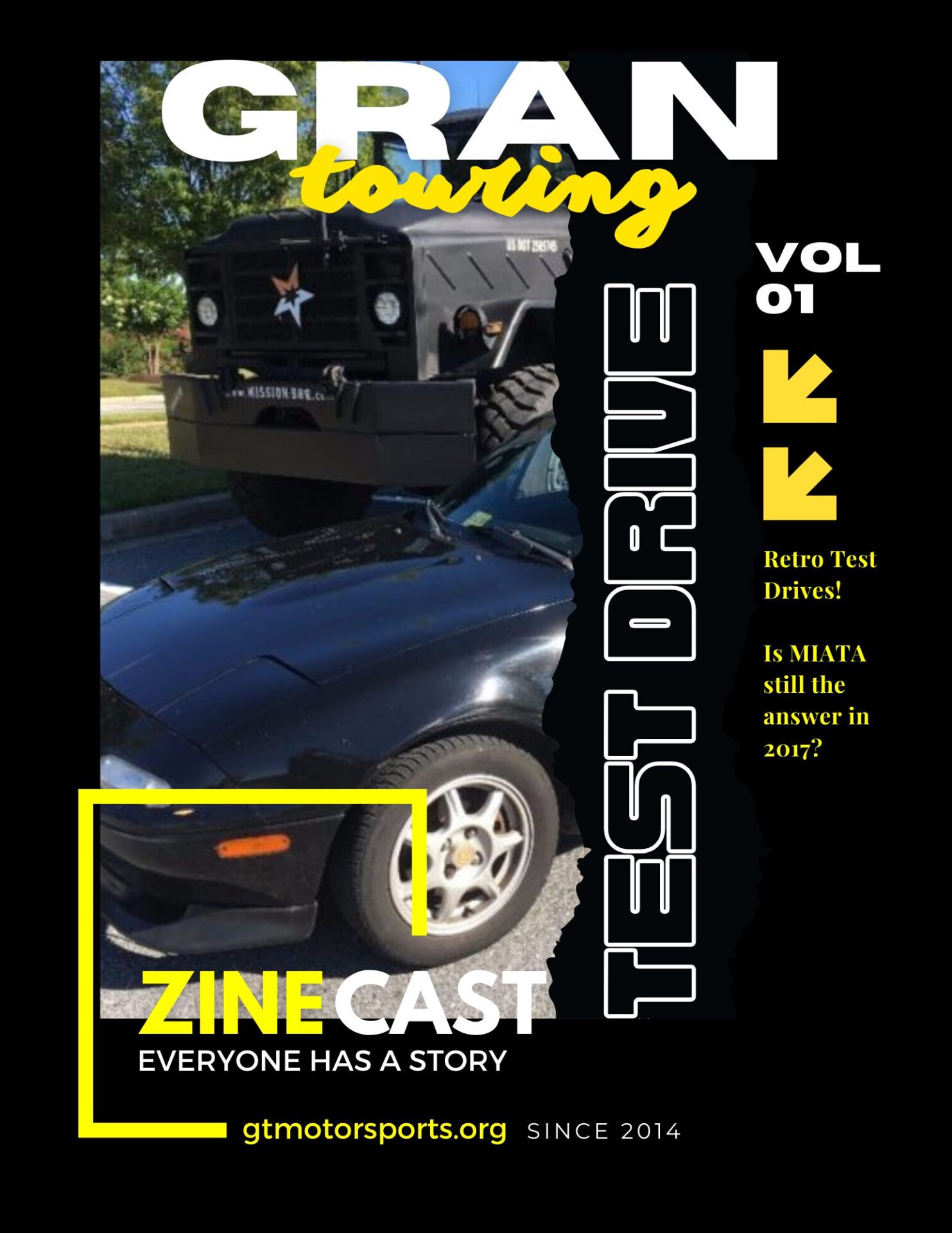Dialing up our “way back machine” we could have easily queued up old episodes of MotorWeek and TopGear, or re-read articles from MotorTrend and Car&Driver, to provide you with amazing facts and pre-production propaganda about our featured 1997 Mazda Mx-5 (Miata); instead we’ve revisited this 20 year old, nearly stock, specimen to give you more of a “How has it held up over time?” review.
I had the task of spending the better part of a few days, and nearly 250 miles behind the wheel of this 211,000 mile 1.8 Liter NA (1st generation) Miata which belongs to GTM Member: Matt Y.
Tune in everywhere you stream, download or listen!
All jokes aside…
The Miata is one of those cars that definitely has a … reputation. I won’t highlight them all here, but if you’ve been in the motoring community long enough you’ve probably heard the jokes.


For this adventure, I needed to dress the part. I abandoned my traditional aviators, tee-shirts and 5 o’clock shadow … and donned what we call at GTM, “the Bowser.” (below)
Let’s cover the Good, the Bad and the Extremely Cramped.
I’ve been practicing this odd concept called “positivism” so let’s start with the Miata’s high points…
Despite the mid-90s utilitarian interior, the Japanese designers at Mazda managed to create something so simple and rather elegant with the interior styling. The interior layout and components still work even in today’s technology enabled motoring world.
Every control and dial is exactly where you think it should be, no searching about for “Where did they hide the headlight switch?” – all of the items are clearly marked and easy to use. In comparison, take a look inside of an early ’90s toyota, even a BMW or VW, the interiors look dated, almost trying to be futuristic but usually chunky and clunky. The shifter is a delight, accurate, weighted and you have a sense of it’s directness to the gearbox – heel/toe shifting comes natural. Throttle response feels like you are revving up a Cessna not a car, much like roadsters than inspired the Miata, it spins up like a Fiat or MG. You feel as though it’s going to rev to 10,000 rpm.
The Miata has that British sports car feel – it doesn’t have an overwhelming amount of power; but the car is light, clocking in at 2300 lbs in full trim. The power is “just right” — but don’t ever look at the speedo or you’ll be completely disappointed; just tune into the hum of the motor and enjoy the scenery going by. On it’s best day, this Miata *could* make a whopping 100 whp; bone stock, around 133 bhp. Despite the age of this Miata, we won’t address “loss of bhp over time.” Even on a worn out suspension the car handles amazingly well, even more amazing on the 14” tires, dated from over 10 years ago. Turn in is immediate and the steering is very accurate. Simply put: The car is light, agile and competent.
“Smallness” means zipping through traffic is like navigating an autocross course and parking is awesome – be mindful to pull up to the *back* of a parking spot so that Nancy-the-Soccer-Mom’s SUV doesn’t plow into the back of your Miata when you run into the Hair Cuttery. Parallel parking is a breeze, a definite PASS for folks taking their driving test. Moreover, the turning circle is so tight you feel like you could make a U-turn in your parking spot. 3-point turn – CHECK!
Admittedly, it’s not the best highway cruiser, but once you get off the highways and onto the B-roads the Miata really comes to life, it’s an absolute bomb-stormer to drive on a country road, there will be few cars that can keep up with your pace. The brake system that clamps down on the *massive* 9-inch rotors could be made from petrified dog poop and sawdust and the Miata would still stop on a dime and give you back quarters. You actually have to be careful that someone doesn’t run into the back of you when stopping quickly in traffic.
If you’re not familiar with the Miata’s “greatness” here’s the basic info you need to know:
Engine | 1.8L, 16-valve, Inline 4 cylinder, Longitudinal Mount, Gas |
Power | 133 bhp @ 6500 rpm |
Curb Weight | 2300 lbs. |
Drivetrain | 5-speed manual, RWD |
Dimensions | Length – 155.4 inches (13 feet) Height – 48.2 inches (4 feet) Wheelbase – 89.2 inches (7.4 feet) Turning Circle – 30 feet |
MPG | EPA estimated 20/26 mpg. 87-octane is OK! **In total, we spent $12.75 on fuel to fill the tank! |
Specifications: Sourced from Edmunds.com
And now for the “glass half empty” portion:
With the Miata clocking in at 4 feet tall (on stock suspension) it sits below the belt line of most vehicles made in the last 5-7 years; most people can’t see the car and you have a hard time seeing over them. Visibility is poor at best (unless you’re parking). You can, however, get a very good view of the aforementioned Nancy’s 20” SUV rims. The side mirrors are too close to the driver, but we fear the only alternative would have been to mount them on the front fenders like a Late 60s Nissan 240-Z or GT-R.
The Miata (especially with a Hard Top) is very difficult for someone above 5’10” to drive comfortably for long periods of time. The cabin is extremely small and without seat modifications is just utterly cramped. Road noise by today’s standards is unacceptable, even with Bluetooth and some ambient noise suppression you best plan on being on/off mute constantly and quickly if you’re trying to entertain a webex while on your way to work. Most Miata owners would probably agree, never bring a beverage into the car unless it has a screw-on top (and it better seal really well); because the Miata doesn’t have any room for cup holders. Our road tested car had an optional add-on holder which squeezed between the tunnel and the passenger seat. This is good for a single commuter, but needs to be removed if you want to bring a passenger, or your Jack-Russel-Mix, Trixie along. Your starbucks Latte will have to be enjoyed *before* returning to your Miata. The front passenger footwell + seat are more useful for hauling groceries than the trunk – which is catastrophically small.
Even with the windows open (and the Hard Top in place) there is very little airflow in the cabin. Removing the top opens you up to the world, but there are downsides to that too. The Soft Top is quietly tucked away, but where do you store the Hard Top if you didn’t plan ahead? You can remove the Hard Top on your own, but it’s rather awkward. Getting help from a friend makes the process a lot easier. The center tunnel gets extremely warm during long stints on the highway, causing the hairs on your right leg to eventually singe from the heat. Turning on the A/C robs the engine of a noticeable amount of horsepower. If you choose to run the A/C instead of dropping the top, switch it off and downshift to pass, especially going up-hill. Gear ratios are extremely short, 4000 rpm at 70 mph – which makes the car feel “peppy” but kills your overall MPG. The only upgrade to the car we tested was an aftermarket (Borla) exhaust system. This modification lead to a numbing resonance in the cabin due to the high revving at highway speeds.
The NA (1st generation) Miata is one of those cars that by most critics opinions doesn’t hold a candle to today’s standards in sports cars or innovation. Most driving today is spent slogging through the hellacious stop-n-go traffic wars, with technology and gizmos to soothe you to and from the office. But cars from the same era as the Miata (ie: GTIs, Sciroccos, MR2s, E30s, etc) remind you WHY we do this, why we like cars. They bring you back to when “driving freedom” existed, much like that feeling you got when you first started driving without parental supervision.
The Answer is Always Miata…
Leave the Hard Top at home, pack your flip flops, a bathing suit, dog treats for Trixie and hit the beach with just enough snacks from 7-eleven to keep you satiated. You’ll have to take the good with the bad, but in my opinion, the Miata is that right blend of everything that makes driving FUN!
Tune in everywhere you stream, download or listen!
#merrymotoring




























